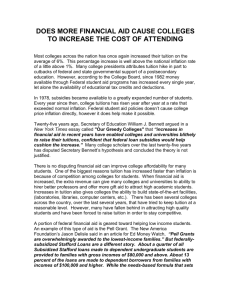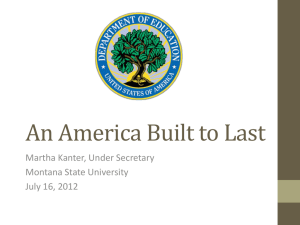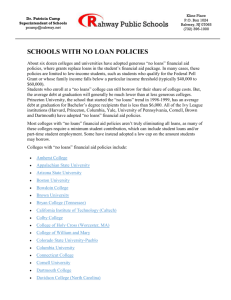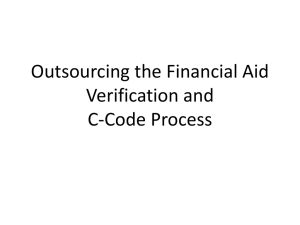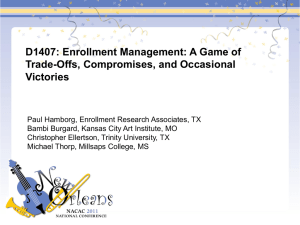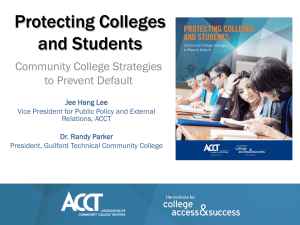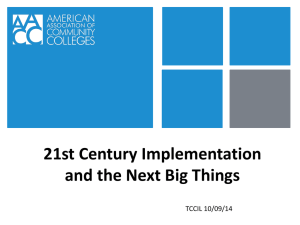US Department of Education, Lynn Mahaffie
advertisement
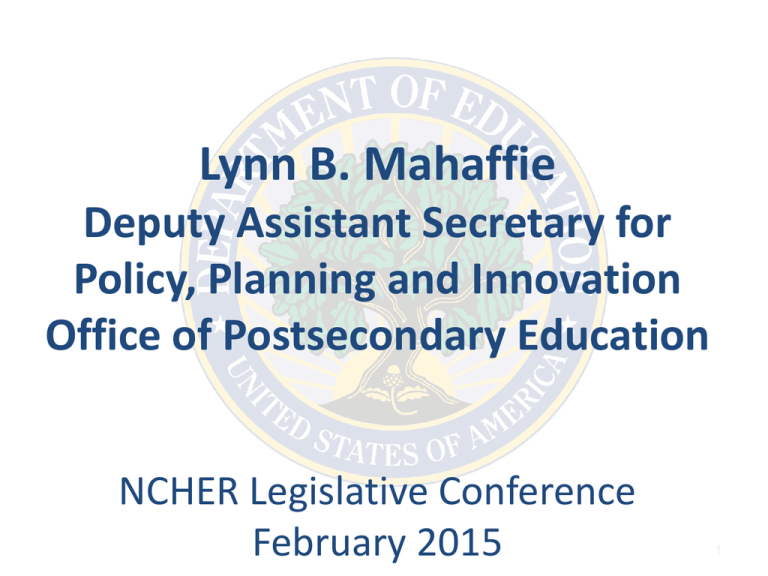
Lynn B. Mahaffie Deputy Assistant Secretary for Policy, Planning and Innovation Office of Postsecondary Education NCHER Legislative Conference February 2015 1 President Obama’s FY 2016 Budget Proposal 2 President’s FY 2016 Budget • President Obama’s budget reflects his strong belief that education is a vital investment in America’s economy, communities and people. • Request includes $70.7 billion of discretionary funds for Department of Education – a 5.4% increase. • It also includes $ 145 billion in new mandatory spending over the next decade -- $4.3 billion for FY 2016. President’s FY 2016 Budget (con’t) • Four themes – Increase equity and opportunity for all students – Expand high-quality learning programs – Supporting teachers and school leaders – Improving access, affordability and student outcomes in postsecondary education • Cross cutting commitment to using and developing evidence to maximize results President’s FY 2016 Budget Higher Ed • America’s College Promise – would provide two years of free community college for responsible students -- $60.3 billion over 10 years • $29.7 billion investment in Pell Grants – maintain purchasing power after 2017 • FAFSA simplification – eliminates up to 30 questions • $200 million for American Technical Training Fund – joint effort with the Department of Labor to expand job opportunities America’s College Promise Proposal •Overview •The President is calling on Congress to help make two years of community college free, for all responsible students, nationwide •The proposal would be undertaken in partnership with states and would let students earn the first half of a bachelor’s degree or earn skills needed in the workforce at no cost •Would benefit nearly nine million students, making higher education more affordable and saving a full-time community college student an average of $3,800 in tuition per year 6 America’s College Promise Proposal •Everyone has a shared responsibility •Federal Government: Will cover three-quarters of the average cost of community college •States: States that choose to participate will be expected to contribute the remaining funds necessary to eliminate community college tuition for eligible students •Community Colleges: Colleges have to ensure that their programs enable students to transfer to a four-year degree or that there are occupational programs for high-demand jobs, demonstrating strong graduation rates and a focused effort to help their students succeed •Students: Must attend at least half-time, maintain a 2.5 GPA in college, and make steady progress towards completing their 7 program Regulatory Update 8 Higher Education Regulatory Initiatives Ensuring that student debt remains affordable Protecting students from being buried in debt that they cannot repay Keeping college campuses safe Increasing access for underserved populations Making sure that teachers are well-prepared upon entering the classroom 9 Pay As You Earn Expansion – Federal Register Notice published Sept. 3, 2014 – We propose to develop regulations that: Allow more students the opportunity to cap their monthly student loan payments at 10% Target the new PAYE option to borrowers who would otherwise struggle to repay their student loans Pay As You Earn Expansion • Two public hearings held in late 2014 in Washington, DC and Anaheim, CA • Federal Register Notice inviting negotiator nominations published in December 2014 – committee selected late last week • Negotiating sessions will begin Feb. 24-26, 2015: Three sessions Approximately 3 days each At roughly monthly intervals Teacher Preparation • Teacher Preparation Negotiated Rulemaking Committee • • • • • • Negotiations were held in November 2012 Consensus not reached NPRM published on December 3, 2014 Comment period closed February 2nd We received over 3,600 comments Except for the Teach Grant component, these proposed regulations are not subject to the Master Calendar requirements Recent Regulatory Efforts Gainful Employment Final rule published October 31, 2014 Effective July 1, 2015 Violence Against Women Act Final rule published October 20, 2014 Effective July 1, 2015 Program Integrity and Improvement PLUS portion published October 23, 2014 Will implement early – March 29, 2015 Program Integrity and Improvement Issues negotiated: Cash management State authorization of distance education programs State authorization of foreign locations of domestic institutions Definition of PLUS adverse credit history Repeat coursework Clock-to-credit hour conversion Tentative agreement reached on some issues, but overall consensus not reached Program Integrity and Improvement • Definition of PLUS adverse credit history • NPRM published on August 8, 2014 • Final rule published October 23, 2014 • Effective July 1, 2015. However, ED will early implement on March 29, 2015. • Revised definitions and amounts apply to both Parent PLUS and Grad PLUS loans • Revised adverse credit definition • If the applicant has one or more debts with combined outstanding balance greater than $2,085 that is: (1) 90 or more days delinquent or (2) placed in collection or charged off during previous two years of credit report • $2,085 can be increased by ED based on CPI if the change would be ≥ $100 • Borrowers with extenuating circumstances or endorser must complete counseling Other ED Activities 16 College Ratings •College Ratings Framework •Released on December 19, 2014 •Inviting comment from the public until February 19, 2015 •The purpose of the college ratings system is to: •Help colleges and universities measure, benchmark, and improve across shared principles of access, affordability, and outcomes •Provide better information about college value to students and families to support them as they search for select a college •Generate reliable, useful data that policymakers and the public can use to hold America’s colleges and universities accountable for key performance measures; ensuring wise and effective use of $150 billion in financial aid 17 College Ratings •Principles •Encourage a focus on access, value, affordability and completion •Broad ratings, not specific rankings •Compare colleges with similar missions •Link federal aid to institutions that do the most to help students from disadvantaged backgrounds 18 Perkins Dear Colleague Letter • Issued January 30, 2015 • Absent Congressional Action, schools may not make Perkins loans to new borrowers after September 30, 2015. • Perkins loans for the 2015-16 award year -- if an initial disbursement was made before October 1, 2015, subsequent disbursements can be made on the loan. • Grandfathering provision– Narrow provision that allows schools to make loans to certain students for up to 5 years. – – – – At least one disbursement prior to June 30, 2015 Same institution Same academic program Award only after student has been awarded all Direct Subsidized Loan aid for which the student is eligible 3rd Party Servicer Dear Colleague Letter • January 9th – Department issued guidance to institutions that contract with 3rd party servicers • Reminds institutions of obligation to report and update • Clarifies which types of entities should be reported as third party servicers Pell and Juvenile Justice – Dear Colleague Letter • Provides additional guidance on the eligibility of Pell Grants for incarcerated students by pointing out that individuals housed in juvenile justice facilities are eligible for Pell. • These juvenile justice facilities (local and county jails) are not Federal or State penal institutions and do not meet the definition under the HEA. As such, students detained in juvenile justice facilities are eligible for Pell (34 CFR §600.2). • It is the responsibility of the institution to determine if the facility qualifies as a juvenile justice facility. First in the World • Part of a national agenda to lead the world in proportion of citizens with postsecondary degrees and credentials • Spur innovation to drive down costs and maintain quality • Support projects that lead to proven results • Support innovative and novel solutions to higher ed. challenges First in the World • Nearly 500 applications were submitted for the FY 2014 FITW grant competition • $75 million awarded to 24 colleges and universities • The 24 colleges and universities selected for this initial year of awards represent 17 states, 19 public, private, and nonprofit 4-year institutions and five public and private two-year institutions • Six of the 24 winning applications—including an HBCU—are from minority serving institutions (MSIs), which will receive about $20 million in funding • New competition in FY 2015
